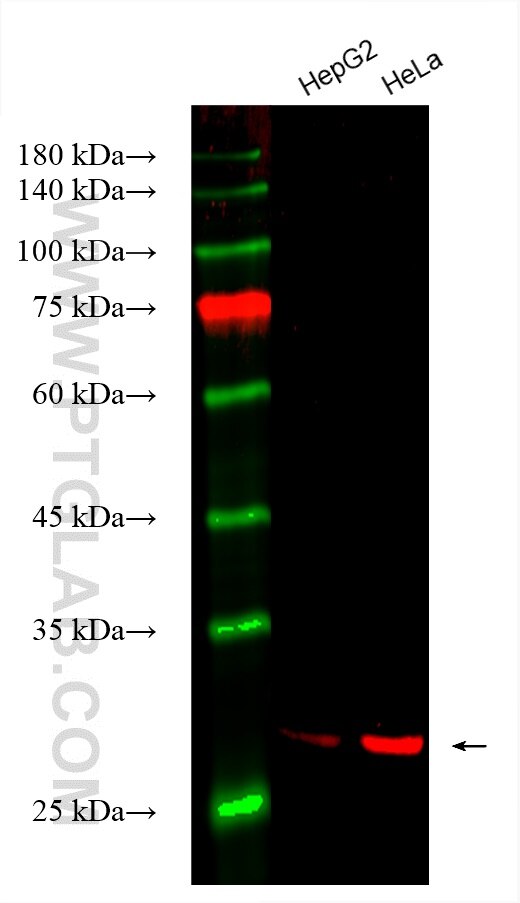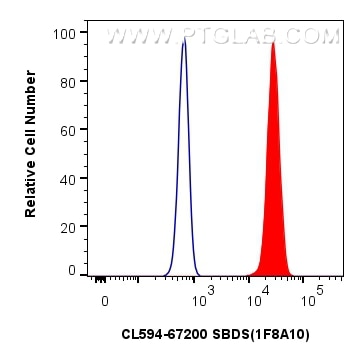Validation Data Gallery
Tested Applications
| Positive WB detected in | HepG2 cells, HeLa cells |
| Positive FC (Intra) detected in | HeLa cells |
Recommended dilution
| Application | Dilution |
|---|---|
| Western Blot (WB) | WB : 1:500-1:2000 |
| Flow Cytometry (FC) (INTRA) | FC (INTRA) : 0.40 ug per 10^6 cells in a 100 µl suspension |
| It is recommended that this reagent should be titrated in each testing system to obtain optimal results. | |
| Sample-dependent, Check data in validation data gallery. | |
Product Information
CL594-67200 targets SBDS in WB, FC (Intra) applications and shows reactivity with human, mouse, rat samples.
| Tested Reactivity | human, mouse, rat |
| Host / Isotype | Mouse / IgG2a |
| Class | Monoclonal |
| Type | Antibody |
| Immunogen | SBDS fusion protein Ag11731 相同性解析による交差性が予測される生物種 |
| Full Name | Shwachman-Bodian-Diamond syndrome |
| Calculated molecular weight | 250 aa, 29 kDa |
| Observed molecular weight | 29-31 kDa |
| GenBank accession number | BC065700 |
| Gene Symbol | SBDS |
| Gene ID (NCBI) | 51119 |
| RRID | AB_3673516 |
| Conjugate | CoraLite®594 Fluorescent Dye |
| Excitation/Emission maxima wavelengths | 588 nm / 604 nm |
| Form | Liquid |
| Purification Method | Protein A purification |
| UNIPROT ID | Q9Y3A5 |
| Storage Buffer | PBS with 50% glycerol, 0.05% Proclin300, 0.5% BSA , pH 7.3 |
| Storage Conditions | Store at -20°C. Avoid exposure to light. Stable for one year after shipment. Aliquoting is unnecessary for -20oC storage. |
Background Information
Shwachman-Bodian-Diamond syndrome (SBDS) is a member of a highly conserved protein family that exists from archaea to vertebrates and plants. The protein may function in RNA metabolism. Mutations within its gene are associated with Shwachman-Bodian-Diamond syndrome.This gene encodes a member of a highly conserved protein family that exists from archaea to vertebrates and plants. The encoded protein may function in RNA metabolism. Mutations within this gene are associated with Shwachman-Bodian-Diamond syndrome. An alternative transcript has been described, but its biological nature has not been determined. This gene has a closely linked pseudogene that is distally located.
Protocols
| Product Specific Protocols | |
|---|---|
| WB protocol for CL594 SBDS antibody CL594-67200 | Download protocol |
| FC protocol for CL594 SBDS antibody CL594-67200 | Download protocol |
| Standard Protocols | |
|---|---|
| Click here to view our Standard Protocols |

